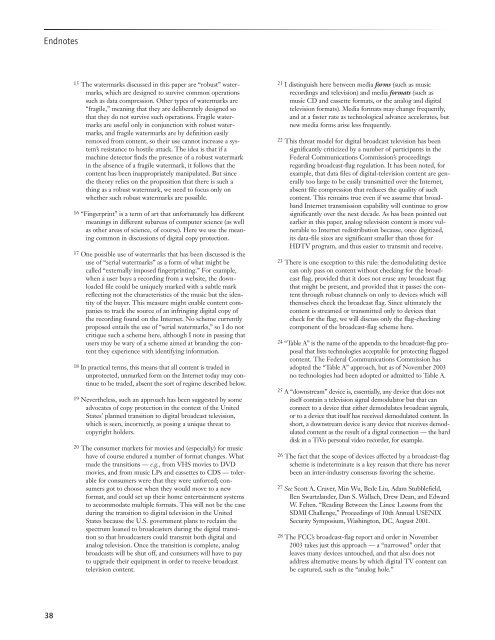What Every Citizen Should Know About DRM, aka - Public Knowledge
What Every Citizen Should Know About DRM, aka - Public Knowledge
What Every Citizen Should Know About DRM, aka - Public Knowledge
Create successful ePaper yourself
Turn your PDF publications into a flip-book with our unique Google optimized e-Paper software.
Endnotes15 The watermarks discussed in this paper are “robust” watermarks,which are designed to survive common operationssuch as data compression. Other types of watermarks are“fragile,” meaning that they are deliberately designed sothat they do not survive such operations. Fragile watermarksare useful only in conjunction with robust watermarks,and fragile watermarks are by definition easilyremoved from content, so their use cannot increase a system’sresistance to hostile attack. The idea is that if amachine detector finds the presence of a robust watermarkin the absence of a fragile watermark, it follows that thecontent has been inappropriately manipulated. But sincethe theory relies on the proposition that there is such athing as a robust watermark, we need to focus only onwhether such robust watermarks are possible.16 “Fingerprint” is a term of art that unfortunately has differentmeanings in different subareas of computer science (as wellas other areas of science, of course). Here we use the meaningcommon in discussions of digital copy protection.17 One possible use of watermarks that has been discussed is theuse of “serial watermarks” as a form of what might becalled “externally imposed fingerprinting.” For example,when a user buys a recording from a website, the downloadedfile could be uniquely marked with a subtle markreflecting not the characteristics of the music but the identityof the buyer. This measure might enable content companiesto track the source of an infringing digital copy ofthe recording found on the Internet. No scheme currentlyproposed entails the use of “serial watermarks,” so I do notcritique such a scheme here, although I note in passing thatusers may be wary of a scheme aimed at branding the contentthey experience with identifying information.18 In practical terms, this means that all content is traded inunprotected, unmarked form on the Internet today may continueto be traded, absent the sort of regime described below.19 Nevertheless, such an approach has been suggested by someadvocates of copy protection in the context of the UnitedStates’ planned transition to digital broadcast television,which is seen, incorrectly, as posing a unique threat tocopyright holders.20 The consumer markets for movies and (especially) for musichave of course endured a number of format changes. <strong>What</strong>made the transitions — e.g., from VHS movies to DVDmovies, and from music LPs and cassettes to CDS — tolerablefor consumers were that they were unforced; consumersgot to choose when they would move to a newformat, and could set up their home entertainment systemsto accommodate multiple formats. This will not be the caseduring the transition to digital television in the UnitedStates because the U.S. government plans to reclaim thespectrum loaned to broadcasters during the digital transitionso that broadcasters could transmit both digital andanalog television. Once the transition is complete, analogbroadcasts will be shut off, and consumers will have to payto upgrade their equipment in order to receive broadcasttelevision content.21 I distinguish here between media forms (such as musicrecordings and television) and media formats (such asmusic CD and cassette formats, or the analog and digitaltelevision formats). Media formats may change frequently,and at a faster rate as technological advance accelerates, butnew media forms arise less frequently.22 This threat model for digital broadcast television has beensignificantly criticized by a number of participants in theFederal Communications Commission’s proceedingsregarding broadcast-flag regulation. It has been noted, forexample, that data files of digital-television content are generallytoo large to be easily transmitted over the Internet,absent file compression that reduces the quality of suchcontent. This remains true even if we assume that broadbandInternet transmission capability will continue to growsignificantly over the next decade. As has been pointed outearlier in this paper, analog television content is more vulnerableto Internet redistribution because, once digitized,its data-file sizes are significant smaller than those forHDTV program, and thus easier to transmit and receive.23 There is one exception to this rule: the demodulating devicecan only pass on content without checking for the broadcastflag, provided that it does not erase any broadcast flagthat might be present, and provided that it passes the contentthrough robust channels on only to devices which willthemselves check the broadcast flag. Since ultimately thecontent is streamed or transmitted only to devices thatcheck for the flag, we will discuss only the flag-checkingcomponent of the broadcast-flag scheme here.24 “Table A” is the name of the appendix to the broadcast-flag proposalthat lists technologies acceptable for protecting flaggedcontent. The Federal Communications Commission hasadopted the “Table A” approach, but as of November 2003no technologies had been adopted or admitted to Table A.25 A “downstream” device is, essentially, any device that does notitself contain a television signal demodulator but that canconnect to a device that either demodulates broadcast signals,or to a device that itself has received demodulated content. Inshort, a downstream device is any device that receives demodulatedcontent as the result of a digital connection — the harddisk in a TiVo personal video recorder, for example.26 The fact that the scope of devices affected by a broadcast-flagscheme is indeterminate is a key reason that there has neverbeen an inter-industry consensus favoring the scheme.27 See Scott A. Craver, Min Wu, Bede Liu, Adam Stubblefield,Ben Swartzlander, Dan S. Wallach, Drew Dean, and EdwardW. Felten. “Reading Between the Lines: Lessons from theSDMI Challenge,” Proceedings of 10th Annual USENIXSecurity Symposium, Washington, DC, August 2001.28 The FCC’s broadcast-flag report and order in November2003 takes just this approach — a “narrowed” order thatleaves many devices untouched, and that also does notaddress alternative means by which digital TV content canbe captured, such as the “analog hole.”38





